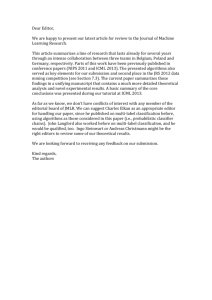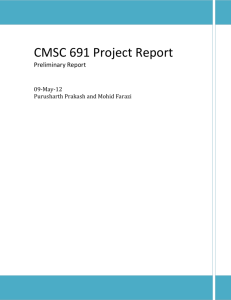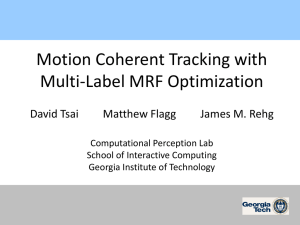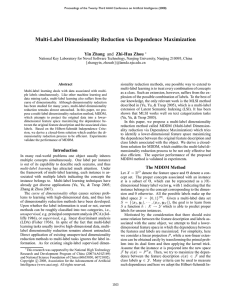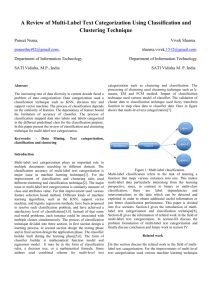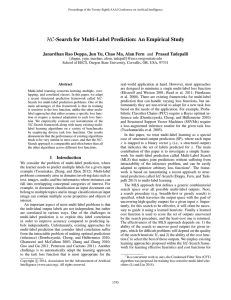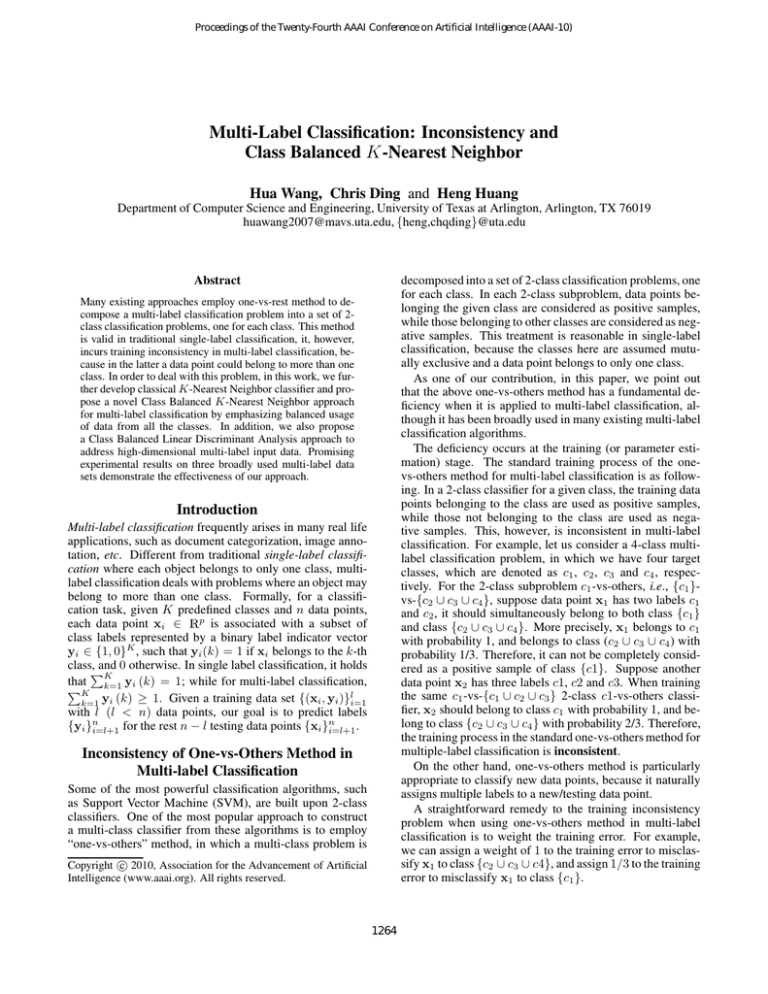
Proceedings of the Twenty-Fourth AAAI Conference on Artificial Intelligence (AAAI-10)
Multi-Label Classification: Inconsistency and
Class Balanced K-Nearest Neighbor
Hua Wang, Chris Ding and Heng Huang
Department of Computer Science and Engineering, University of Texas at Arlington, Arlington, TX 76019
huawang2007@mavs.uta.edu, {heng,chqding}@uta.edu
Abstract
decomposed into a set of 2-class classification problems, one
for each class. In each 2-class subproblem, data points belonging the given class are considered as positive samples,
while those belonging to other classes are considered as negative samples. This treatment is reasonable in single-label
classification, because the classes here are assumed mutually exclusive and a data point belongs to only one class.
As one of our contribution, in this paper, we point out
that the above one-vs-others method has a fundamental deficiency when it is applied to multi-label classification, although it has been broadly used in many existing multi-label
classification algorithms.
The deficiency occurs at the training (or parameter estimation) stage. The standard training process of the onevs-others method for multi-label classification is as following. In a 2-class classifier for a given class, the training data
points belonging to the class are used as positive samples,
while those not belonging to the class are used as negative samples. This, however, is inconsistent in multi-label
classification. For example, let us consider a 4-class multilabel classification problem, in which we have four target
classes, which are denoted as c1 , c2 , c3 and c4 , respectively. For the 2-class subproblem c1 -vs-others, i.e., {c1 }vs-{c2 ∪ c3 ∪ c4 }, suppose data point x1 has two labels c1
and c2 , it should simultaneously belong to both class {c1 }
and class {c2 ∪ c3 ∪ c4 }. More precisely, x1 belongs to c1
with probability 1, and belongs to class (c2 ∪ c3 ∪ c4 ) with
probability 1/3. Therefore, it can not be completely considered as a positive sample of class {c1}. Suppose another
data point x2 has three labels c1, c2 and c3. When training
the same c1 -vs-{c1 ∪ c2 ∪ c3 } 2-class c1-vs-others classifier, x2 should belong to class c1 with probability 1, and belong to class {c2 ∪ c3 ∪ c4 } with probability 2/3. Therefore,
the training process in the standard one-vs-others method for
multiple-label classification is inconsistent.
On the other hand, one-vs-others method is particularly
appropriate to classify new data points, because it naturally
assigns multiple labels to a new/testing data point.
A straightforward remedy to the training inconsistency
problem when using one-vs-others method in multi-label
classification is to weight the training error. For example,
we can assign a weight of 1 to the training error to misclassify x1 to class {c2 ∪ c3 ∪ c4}, and assign 1/3 to the training
error to misclassify x1 to class {c1 }.
Many existing approaches employ one-vs-rest method to decompose a multi-label classification problem into a set of 2class classification problems, one for each class. This method
is valid in traditional single-label classification, it, however,
incurs training inconsistency in multi-label classification, because in the latter a data point could belong to more than one
class. In order to deal with this problem, in this work, we further develop classical K-Nearest Neighbor classifier and propose a novel Class Balanced K-Nearest Neighbor approach
for multi-label classification by emphasizing balanced usage
of data from all the classes. In addition, we also propose
a Class Balanced Linear Discriminant Analysis approach to
address high-dimensional multi-label input data. Promising
experimental results on three broadly used multi-label data
sets demonstrate the effectiveness of our approach.
Introduction
Multi-label classification frequently arises in many real life
applications, such as document categorization, image annotation, etc. Different from traditional single-label classification where each object belongs to only one class, multilabel classification deals with problems where an object may
belong to more than one class. Formally, for a classification task, given K predefined classes and n data points,
each data point xi ∈ p is associated with a subset of
class labels represented by a binary label indicator vector
yi ∈ {1, 0}K , such that yi (k) = 1 if xi belongs to the k-th
class, and 0 otherwise. In single label classification, it holds
PK
that k=1 yi (k) = 1; while for multi-label classification,
PK
l
k=1 yi (k) ≥ 1. Given a training data set {(xi , yi )}i=1
with l (l < n) data points, our goal is to predict labels
{yi }ni=l+1 for the rest n − l testing data points {xi }ni=l+1 .
Inconsistency of One-vs-Others Method in
Multi-label Classification
Some of the most powerful classification algorithms, such
as Support Vector Machine (SVM), are built upon 2-class
classifiers. One of the most popular approach to construct
a multi-class classifier from these algorithms is to employ
“one-vs-others” method, in which a multi-class problem is
c 2010, Association for the Advancement of Artificial
Copyright Intelligence (www.aaai.org). All rights reserved.
1264
much it should contribute to the between-class and withinclass scatters remains unclear.
Therefore, instead of computing the scatter matrices from
data points perspective as in standard LDA, we propose
PK
to formulate them by class-wise, i.e., Sb =
k=1 Sb (k),
PK
PK
Sw = k=1 Sw (k), and St = k=1 St (k). In this way,
the structural variances of the training data are represented
more lucid and the construction of the scatter matrices turns
out easier. Especially, the ambiguity, how much a data point
with multiple labels should contribute to the scatter matrices,
is avoided. The multi-label between-class scatter matrix is
defined as:
Another multi-class/label classifier construction approach
from 2-class classifiers is “one-vs-one” method, which also
decomposes a multi-class/label problem into a set of 2-class
subproblems, one for each class pair. This approach solves
the above training inconsistency problem. When training ck vs-cl 2-class classifier, if (1) data points with both class labels ck and cl are excluded, and (2) data point not belonging
to either class are excluded, the rest data points are uniquely
used by either ck or cl . However, the classification of new
data points for multi-label problem requires a threshold to
determine how many labels the new data point should acquire. In addition, as well known, one-vs-one method requires 2K sub-classifiers, which could easily lead to explosion of computation.
An entirely new direction to avoid the training inconsistency problem is to use non-parametric classification methods, such as K-Nearest Neighbor (KNN) classifier, either
directly on the original input space or on a reduced feature space, because there is no training phase involved. The
KNN approach, however, suffers from unbalanced data distribution problem, which become more severe for multilabel problem. Fundamentally, because we need to assign
multiple labels to a test data point, a simple 1NN or 3NN do
not have enough information for this multi-label assignment
(in contrast to single label), which will be discussed in detail
later in algorithm description section.
In this work, we deal with the training inconsistency problem incurred by one-vs-others method in multi-label classification. We take the perspective to use non-parametric classification method and propose our Class Balanced K-Nearest
Neighbor (BKNN) approach for multi-label classification
by emphasizing balanced usage of data from all the classes.
The aforementioned problems in non-parametric classification methods are solved in our BKNN approach. We
also propose a Class Balanced Linear Discriminant Analysis
(BLDA) method to embed high-dimensional multi-label input data into a lower dimensional space, which can be used
for optional dimensionality reduction prior to classification.
l
K
(k)
Sb =
(k)
Sb , S b
=
Yik
(mk − m)(mk − m)T , (1)
i=1
k=1
the multi-label within-class scatter matrix Sw is defined as:
l
K
(k)
(k)
Sw
, Sw
=
Sw =
k=1
Yik (xi − mk ) (xi − mk )T , (2)
i=1
where mk is the mean of class k and m is the multi-label
global mean, which are defined as follows:
Pl
PK Pl
Yik xi
k=1
i=1 Yik xi
mk = Pi=1
,
m
=
.
(3)
PK Pl
l
i=1 Yik
k=1
i=1 Yik
Note that, the multi-label global mean m defined in Eq. (3)
is different from the global mean in single-label sense as in
Pl
standard LDA. The latter is defined as 1l i=1 xi .
Equipped with the class-wise scatter matrices defined
in Eqs. (1–2), we can compute the transformation matrix
U ∈ p×r following the standard LDA algorithm (Fukunaga 1990), where r is the reduced dimensionality. The projected data points are hence computed by qi = U T xi .
Class Balanced K-Nearest Neighbor Classifier
Given input data, either original features xi or reduced features qi , we may use statistical learning method to conduct
classification. Considering the training inconsistency problem of one-vs-others method in multi-label classification, we
consider to use KNN classifier due to its non-parametric
property. However, the following difficulties prevent us
from directly using the classical KNN classifier.
The first one is the unbalanced data distribution. The second one is the thresholding problem, which is also caused
by the nature of multi-label data. For example, for a 4-class
multi-label classification problem same as before, we use
3NN and assume a testing data point xi has the following
nearest neighbors, x1 with labels c3 and c4 , x2 with labels
c2 , c3 and c4 , x3 with labels c1 and c4 . Therefore, the most
frequently appearing labels in the neighbors of the testing
data point xi are sorted as following: c4 for 3 times, c3 for 2
times, c1 for 1 times and c2 for 1 times. Apparently, c4 will
be assigned to xi if this is a single-label problem. However,
in multi-label case, a threshold is required to make classification and it is hard to select an optimal one.
In order to exploit its non-parametric property, in this section, we further develop classical KNN method, and propose a Class Balanced K-Nearest Neighbor (BKNN) approach for multi-label classification. The aforementioned
Class Balanced Linear Discriminant Analysis
Same as single-label classification, high-dimensional input data could make multi-label classification computationally infeasible due to “curse-of-dimensionality” (Fukunaga
1990). Therefore, dimensionality reduction to prune irrelevant features and reduce dimensionality is necessary prior
to classification. In this work, we further develop the classical LDA to reduce the dimensionality of multi-label data.
We first point out the difficulties in computing the scatter
matrices when using traditional single-label definitions in
multi-label classification, and then propose our class-wise
multi-label scatter matrices to deal with the problem. Meanwhile the powerful classification capability inherited from
classical LDA is preserved.
In traditional single-label multi-class classification, the
scatter matrices Sb and Sw are well defined in standard LDA
algorithm as per the geometrical dispersion of data points.
These definitions, however, become obscure when applied
to multi-label classification. Because a data point with multiple labels belong to different classes at the same time, how
1265
two problems in classical KNN classifier are solved by our
BKNN approach.
Algorithm. Step 1. Given a test data point xi (l + 1 <
i ≤ n), we pick up b nearest neighboring data points in each
class. This leads to at most K × b data points, denoted as
(k)
Γi . Let {xij }bj=1 be the data points in Γi for the kth class,
given a similarity matrix W ∈ n×n with Wij indicating
the similarity between xi and xj , we define:
PK (k)
b
X
s
(k)
(k)
si =
W (xij , xi ), and s¯i = k=1 i , (4)
K
j=1
where W (xi , xj ) = exp −kxi − xj k2 /2σ in this work.
Step 2. We compute the Balanced K-Nearest Neighbor
Decision Score of a test data point xi for the k-th class as:
Table 1: Multi-label classification performance measured by
“average precision” for the four compared approaches.
SMSE
MLLS
MCGF
BKNN (b = 5)
(k)
=
TRECVID
Yahoo
Music
10.7%
23.7%
24.9%
25.6%
13.5%
27.6%
24.3%
26.8%
21.3%
31.2%
30.3%
36.2%
We apply the compared approaches on the following three
broadly used multi-label datasets from different applications: TRECVID 2005 dataset (Smeaton, Over, and Kraaij
2006) (image), Music emotion dataset (Trohidis et al. 2008)
(music), and Yahoo dataset (“Science” topic) (Ueda and
Saito 2002) (document). For performance evaluation, we
adopt “Average Precision” as recommended by TRECVID
(Smeaton, Over, and Kraaij 2006), which computes the precision for each class and average them over all the classes.
We adopt “Average Precision” as our performance metric
as recommended by TRECVID (Smeaton, Over, and Kraaij
2006), which computes the precision for each class and average them over all the classes.
Table 1 presents the overall classification performance
comparisons measured by average precision on the three
data sets. The results show that the proposed BKNN
approach outperforms all the other compared approaches,
which quantitatively demonstrate the advantage of our approach.
− s¯i
.
(5)
s¯i
Step 3. In order to decide the class membership of xi ,
we learn a threshold from training data. We first compute
(k)
fi for all the training data points for the kth class. Given
a threshold hk , let pk (hk ) and rk (hk ) denote the corresponding “precision” and “recall” on the training data using
(k)
{fi }li=1 , we select our Adaptive Decision Boundary as:
!
2
opt
,
(6)
hk = arg max
α
1−α
hk
pk (hk ) + rk (hk )
(k)
fi
data sets
Approaches
si
where α is an application dependent parameter to determine
how much the “weighted F1 score” should be biased to precision, and empirically selected as 0.5 in this work. Finally,
the labels yi for a test point xi is determined by
(k)
yi (k) = sign fi − hopt
.
(7)
k
Acknowledgments
This research is supported by NSF CCF-0830780, NSF
CCF-0939187, NSF CCF-0917274, NSF DMS-0915228.
References
Obviously, although different class could have very different number of labeled data points, for a given test data point,
we pick up the most representative training data points from
every class with equal number, i.e., b for each class, such
that the label of a test data point is determined via the information from all the classes in a balanced manner.
Note that, b in our approach is a free parameter like K
in KNN, which is normally fine tuned by cross validation.
Empirically, small b gives good classification results.
Chen, G.; Song, Y.; Wang, F.; and Zhang, C. 2008. Semisupervised Multi-label Learning by Solving a Sylvester
Equation. In SDM’08.
Fukunaga, K. 1990. Introduction to statistical pattern recognition. Academic Press.
Ji, S.; Tang, L.; Yu, S.; and Ye, J. 2008. Extracting shared
subspace for multi-label classification. In SIGKDD’08.
Smeaton, A. F.; Over, P.; and Kraaij, W. 2006. Evaluation
campaigns and trecvid. In MIR’06.
Trohidis, K.; Tsoumakas, G.; Kalliris, G.; and Vlahavas, I.
2008. Multilabel classification of music into emotions. In
ISMIR’08.
Ueda, N., and Saito, K. 2002. Single-shot detection of multiple categories of text using parametric mixture models. In
SIGKDD’02.
Wang, H.; Huang, H.; and Ding, C. 2009. Image Annotation
Using Multi-label Correlated Greens Function. In ICCV’09.
Empirical Studies
We use standard 5-fold cross validation to evaluate the proposed BKNN approach in multi-label classification, and
compare the experimental results with the following most recent multi-label classification methods: (1) Semi-supervised
learning by Sylvester Equation (SMSE) (Chen et al. 2008)
method, (2) Multi-Label Least Square (MLLS) (Ji et al.
2008) method and (3) Multi-label Correlated Green’s Function (MCGF) (Wang, Huang, and Ding 2009) method. We
follow the implementation details as in the original works.
The input data are first projected to a lower r dimensional
subspace before being fed into the respective classification
approaches. In our evaluations, we set r = K − 1.
1266

